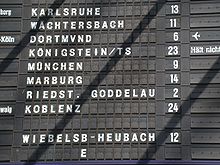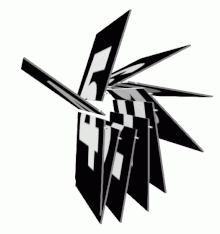Fall leaf display

A leaflet display , sometimes incorrectly called a “leaflet display ”, is primarily used as a display in digital clocks , especially synchronous clocks , as a calendar , in call displays in waiting areas and on display boards at airports and train stations . In the meantime, however, it has largely been replaced by large-format segment displays , matrix displays or bistable display elements . An alternative designation for modules that display entire words at once is a pallet display , and purely numerical displays are also referred to as folding number displays .
construction
Fall leaves are rotatably attached to an axis at an even distance. The back of a tile and the front of the next tile together each show a printed symbol .
The front and back of two subsequent plates are visible through a retaining device. If the axle rotates, the upper plate slides through the retaining device and flips over. This makes the following symbol visible and - especially with older makes - a characteristic rattling occurs; This is why this type of display is colloquially referred to as a "clapboard".
The number of sheets can vary. Single-width modules (for numbers and letters) usually contain 52 drop sheets with numbers, capital letters, punctuation marks and umlauts. Wider modules (with two, four, six, eight or ten times the width) are available with 40, 64 or 80 sheets.
Due to the limited number of plates, only capital letters, numbers and a few special characters are usually available. The up in the last years at the Deutsche Bahn on the platforms as destination displays modules used possessed, for example, only the capital letters A to Z , the umlaut Ä , E , Ü and Å , and the digits 0 to 9 and special characters - , . , ( , ) , ! , : , / , " , , , = .
Some of the more modern advertisements also have a € and an @ sign, as the Krone / MAN-Systeme company in particular produced drop-leaf modules and drop-leaf boards after the year 2000.
On the other hand, old case-sheet modules from the Krone company at airports often have no umlauts and only the three most important special characters - , _ and : due to their internationally understandable priority .
In digital clocks, other symbols are also used to display the hours ( 00 to 23 ) and minutes ( 00 to 59 ). Even with train destination displays on platforms , complex texts (destination stations) and symbols for train types ( IC , ICE , S etc.) and others are often used.
The representation of the symbols and characters is very good because they are printed on and therefore no rasterization is carried out, as is the case, for example, with displays made of bistable display elements . However, the display is limited to the (printed) symbols and is disturbed in the middle by the relatively large gap between the leaves and the connecting rings.
1 80 sheets exclusively for modules with train destination texts
|
|||||||||||||||||||||||||||||||||||||||||||||
function
The structure and control of the fall leaf modules has changed significantly over the years and decades.
- Epoch 1: The switching takes place via a relay , similar to a pulse switch . The position determination and "zero position" (position on the blank sheet display) takes place via a perforated drum (similar to a perforated belt ). Here there was no intelligent addressing of the module, but all modules in one display were controlled with discrete cabling.
- Epoch 2: The switching takes place here via a synchronous motor , which is activated via a Darlington connection . The position and "zeroing" are determined by two magnets that activate the Hall sensors . The intelligent circuit by means of a microcontroller was located outside the module in the housing of the corresponding indicator. The “address” of the module was also permanently programmed into the corresponding microcontroller.
- Epoch 3: The switching takes place via a synchronous motor, which is activated via an optotriac . The position and "zeroing" are determined by light barriers, which are triggered by appropriate gear positions. In this epoch, the microcontroller with all its associated components is also on the drop leaf module. The module is addressed by a small "address board", which was usually located in the housing and into which the module was inserted during installation. The address of the module could then be set individually in binary on a DIP switch . In this era, the ICs were first installed in the THT version, but shortly afterwards also as SMD .
- Epoch 4: The switching takes place via a stepper motor , which is activated via a corresponding motor driver. The position detection and "zeroing" is again done by magnets and Hall sensors, as this system has proven to be more resistant to dust and dirt. The addressing of the modules can either be permanently programmed or set on the corresponding DIP switches. The modules were delivered depending on the requirements. The advantage of the stepper motor with these displays was the lower level of noise and the lack of an AC power supply that would have been necessary for a synchronous motor. This system was only produced and used by OMEGA for SBB in Switzerland and production was finally discontinued in 2006. In Germany they switched to digital displays ( LCD , TFT , LED ) even before that .
Display sheets that fold vertically
The Italian company Solari di Udine developed a special form of the fall leaf display in the 1960s. In their watches, it installed display sheets that fold vertically, also known as "book-fold numbers". There was a small spiral spring on each display sheet bearing that let the sheet fold over to the side. These clocks were also available with day of the week and date in different sizes, whereby the day of the week usually also flipped down horizontally due to its text length. Watches with a date display were equipped with a " perpetual calendar " that took into account the shorter months and leap years .
Use on vehicles
Fall sheet displays are or were used almost exclusively in stationary applications. An exception is the use as a line and / or destination display on vehicles of the local public transport , whereby in this area they were never able to prevail against the older technology of the roller tape display . Examples of such uses are:
- the series A , B 1.4 and B2.7 of the Munich subway (built between 1967 and 1987)
- some wagons of the Berlin subway
- on the Hamburg S-Bahn all trains of the 472 series (built between 1974 and 1984) and 36 trains of the 470 series (retrofitted from 1980)
- the Breda railcars of the Greater Cleveland Regional Transit Authority (built between 1979 and 1982)
- the type KT8D5CS of the Prague tram (built between 1986 and 1990)
- some of the trains used on Line 1 of the Athens Metro (built between 1993 and 1995)
- many Italian city buses during the 1960s to 1980s, some also with vertically folding display sheets from Solari di Udine
Munich subway with two-part case sheet display for the line number on the one hand and the destination on the other
Noise development
Typical for larger drop-leaf display boards at airports and train stations was the noise they made when the display image was updated. In order to make passengers aware of the changes that take place every few minutes, even with modern digital displays , some of them artificially imitate the acoustics , i.e. the characteristic rattling, clacking or hissing, of the earlier displays. At Cologne / Bonn Airport , a system went into operation in 2014 that is not only acoustically but also creatively based on its classic model and optically imitates the previous turning of the page.
Trivia
- In the 1970 film Colossus , the computer that took over the world communicates through a fall-leaf display.
- In the movie Groundhog Day in 1993 one announces clock radio with Flip-over display on the ever-repeating day.
- Improvised case-leaf advertisements have recently been used in animation art
Web links
Individual evidence
- ↑ Round information for the ring - suggestions for principles for the signage of trains on signalarchiv.de, accessed on February 3, 2019
- ↑ mezgrBlog: Fallblatt, the first. Retrieved January 27, 2019 .
- ↑ Fall sheet indicator. Retrieved January 27, 2019 .
- ↑ Control SBB Fallblatt-Anzeiger with esp8266 / Arduino / RasPi! Retrieved January 27, 2019 .
- ↑ nimmbus.de , accessed on February 6, 2019
- ↑ Cologne Bonn Airport (CGN): When the scoreboard rattles digitally on t-systems.com, accessed on January 31, 2019
- ↑ Modern electronics make nostalgic noises - digital " rattle boards " at Cologne Bonn Airport , article on flightrevue.de from October 24, 2014, accessed on January 31, 2019
- ↑ Juan Fontanive: Together (2015)













